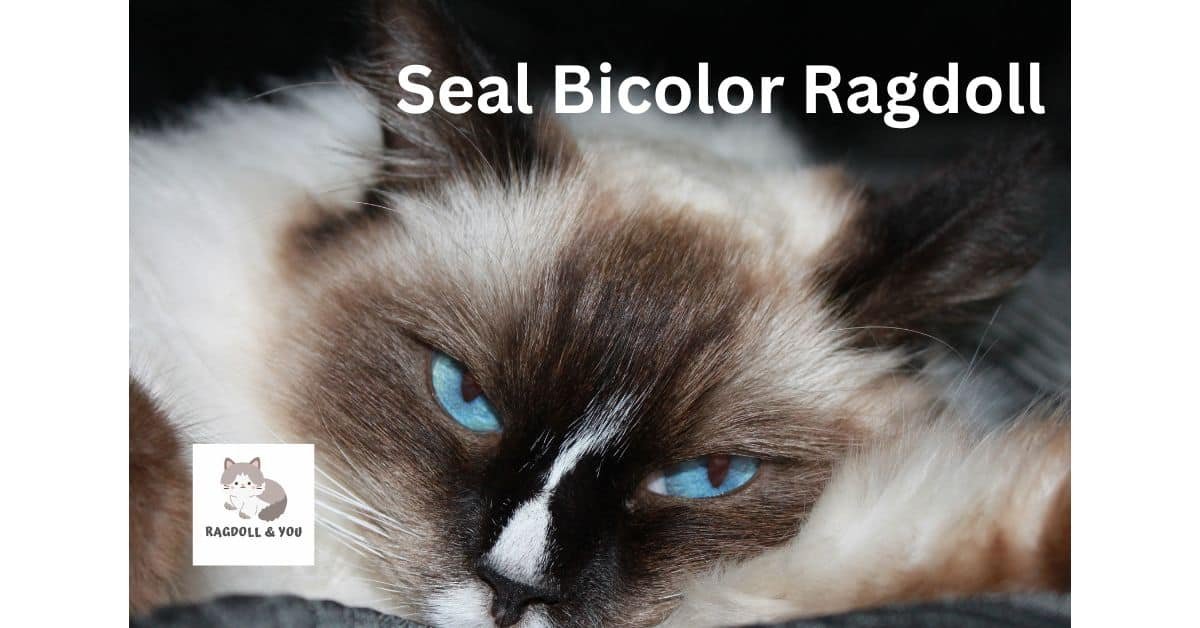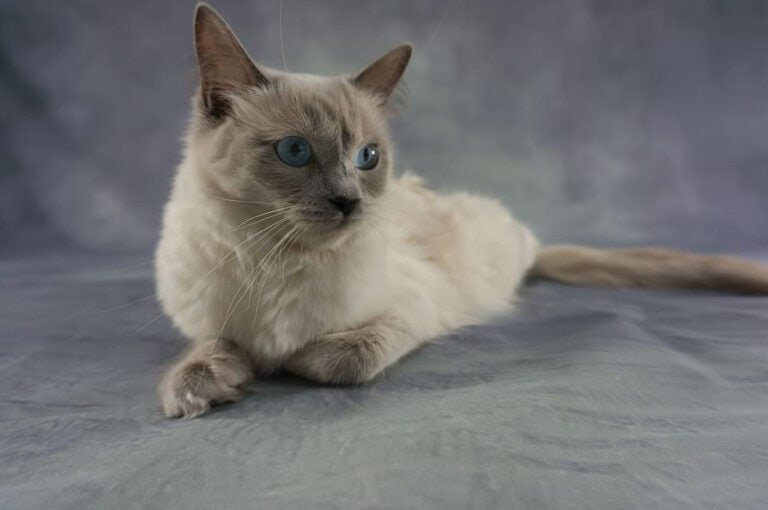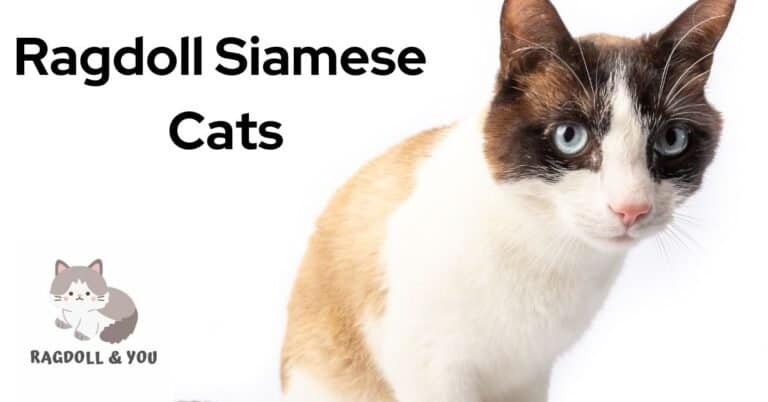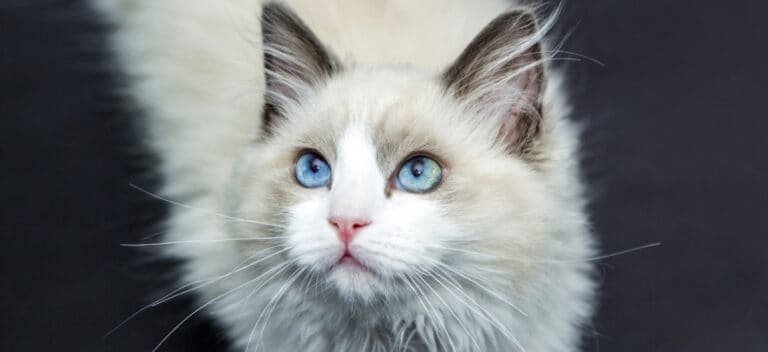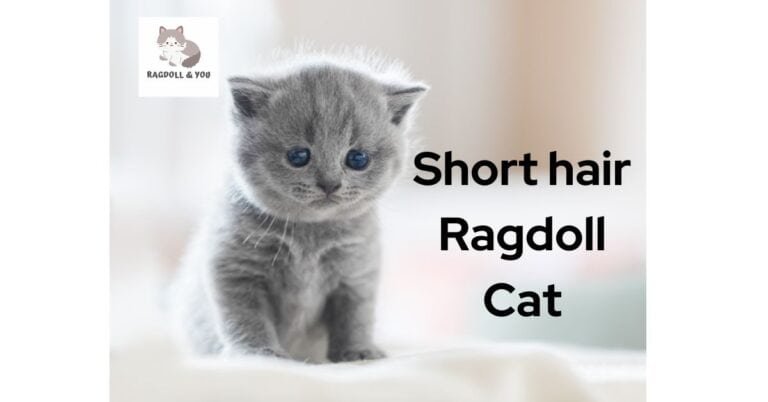A Masterclass On The Seal Bicolor Ragdoll (Complete Guide)
Seal Bicolor Ragdoll is one of the three traditional patterns of Ragdoll cats, along with Colorpoint and Mitted. They have a dark brown (seal) color on their ears, tail, mask, and “saddle” area, and white fur on the rest of their body.
They have blue eyes, pink paw pads, and nose leather. Seal Bicolor Ragdolls are known for their gentle and affectionate personalities and make great family pets.
In our masterclass today, we will unwrap all there is to know about this special breed, from their unique color progression to their care needs and personality traits.
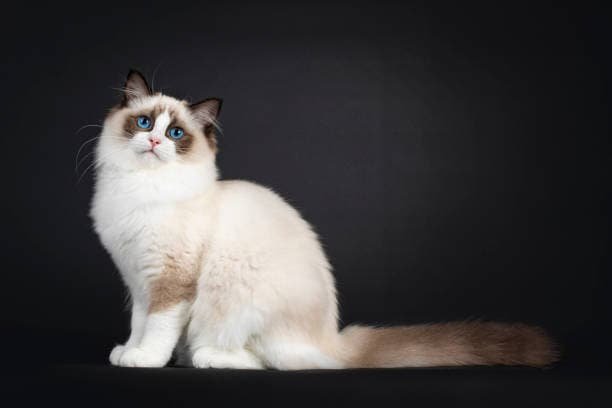
What Is A Seal Bicolor Ragdoll?
A Seal Bicolor Ragdoll is a type of Ragdoll cat breed characterized by its distinct markings and coloration.
Physical Appearance
The Seal Bicolor Ragdoll cat has a unique look. Its soft white fur forms an inverted V shape on its face.
This breed also has white legs, belly, chin, chest, and underside. It is famous for its wide head with big round blue eyes.
A long tail adds charm to its physical features. The bold color pattern grabs the attention of many cat lovers worldwide!
Genetics
Seal Bicolor Ragdoll cats are born all white. A dark brown color appears on their ears and tails as they grow. This dark brown is called a seal point.
The genes that make a cat a seal bicolor Ragdoll are bossy- they control the cat’s looks! Two big boss or “dominant” genes give this type of Ragdoll its special color pattern.
One gene causes the dark brown seal point color. The other gene makes some spots on the cat stay white as it grows up — that’s why it gets called ‘bicolor.’
So, in simple words, if a cat has these two dominant genes, it will be a Seal Bicolor Ragdoll!
Color Progression
Seal Bicolor Ragdolls have a cool color story. They are born all white. Over time, their fur changes to a light brown color at the points.
These are areas where the body is warmer, like ears, tail, and part of the face.
As they grow older, parts of their fur turn into dark brown coloring on their ears, tail, and part of the face. The rest stays white!

Comparison: Seal Bicolor Ragdoll vs. Seal Mitted Ragdoll
The comparison between the Seal Bicolor Ragdoll and Seal Mitted Ragdoll reveals intriguing distinctions between these two variants of the same breed. For a more precise understanding, a tabulated comparison is detailed below:
| Features | Seal Bicolor Ragdoll | Seal Mitted Ragdoll |
| Color Variations | Exhibits color variations such as red, chocolate, blue, cream, and lilac. | Mostly seal (dark brown) color with white mittens on the paws. |
| Color Pattern | Displays a two-toned color pattern with light and dark markings, hence the term ‘bicolor.’ | Features a darker seal color on the points, with a lighter body color. |
| Vocal Ability | Known for their vocal nature. | Generally less vocal compared to the Bicolor variant. |
| Recognition | Recognized as a distinct color variation alongside colorpoint, mitted, and lynx. | Also recognized as a distinct color variation but are majorly known for their mitted (mittens) feature. |
Seal Bicolor Ragdoll Personality and Care
The Seal Bicolor Ragdoll is gentle and affectionate, making them great companions. With proper training and socialization, they can be playful and interactive.
Regular grooming and veterinary care are essential to keep their long coat healthy and ensure their overall well-being.

Temperament
Seal Bicolor Ragdolls have a calm and easygoing temperament. They are friendly, loving, and gentle cats that make great companions. These cats are known for their sociable nature and affectionate behavior towards their owners.
Seal Bicolor Ragdolls enjoy being around people and seek human attention. They are playful but docile cats, making them suitable for families with children or other pets.
These cats can even resemble dogs in terms of their personalities. With their loyalty and sweet disposition, Seal Bicolor Ragdolls bring joy to any household they become a part of.
Ragdolls, including the Seal Bicolor variety, have a unique trait called “floppiness.” This means that when picked up or held, they tend to limp like a ragdoll (hence the name).
Training
Training a Seal Bicolor Ragdoll cat is an essential part of their care. Here are some critical tips for training your furry friend:
- Start early: Begin training your Seal Bicolor Ragdoll when they are still kittens. This will help them develop good habits from a young age.
- Use positive reinforcement: Reward your cat with treats, praise, or playtime when they exhibit desired behaviors. This will motivate them to continue learning and obeying commands.
- Be patient and consistent: Training takes time, so be patient with your cat as they learn new commands or behaviors. Consistency is also crucial – use the same cues and rewards each time you train.
- Use clicker training: Clicker training can be a helpful tool for teaching your Ragdoll cat new tricks or commands. The clicker sound acts as a marker for desired behavior and helps to reinforce positive associations.
- Focus on socialization: Alongside basic obedience training, it’s essential to socialize your Ragdoll cat from an early age. Expose them to different people, animals, and environments to help them become confident and well-adjusted.
- Avoid punishment: Negative reinforcement or punishment can harm the bond between you and your cat. Instead, redirect unwanted behavior using positive alternatives or distraction techniques.
- Seek professional help if needed: If you’re struggling with training or behavioral issues, consider consulting a professional cat trainer specializing in positive reinforcement methods.
Exercise Requirements
Seal Bicolor Ragdolls have a moderate exercise requirement. Here are some ways to ensure they get the physical activity they need:
- Regular playtime: Engage in daily play sessions with your Seal Bicolor Ragdoll. They enjoy interactive toys and games that keep them moving.
- Exercise routine: Establish a regular exercise routine for your cat. This can include designated playtimes throughout the day.
- Playtime variety: Offer a variety of toys and activities to keep your Ragdoll stimulated. This can include puzzle toys, feather wands, or laser pointers.
- Health maintenance: Regular veterinary check-ups are essential to ensure your cat is healthy and can engage in physical activity.
- Mental stimulation: Besides physical exercise, provide mental stimulation for your cat. This can include puzzle feeders or treat-dispensing toys.
- Moderate activity level: While they enjoy playtime, Seal Bicolor Ragdolls are less high-energy than some other breeds. It’s essential to find the right balance of exercise for their individual needs.
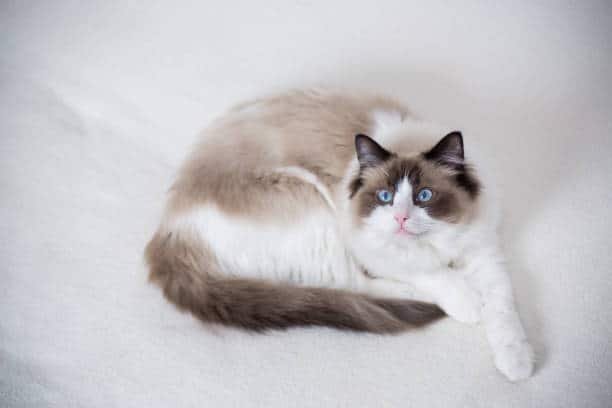
Grooming And Cleaning
Grooming and cleaning are integral to caring for a Seal Bicolor Ragdoll. Here are some tips to keep your cat happy, healthy, and clean:
- Brush the Bicolor Seal Ragdoll 3 to 4 times a week to prevent matting and remove loose hair.
- Use a comb or brush designed for long-haired cats to untangle knots easily.
- Be gentle while brushing their fur to avoid hurting their sensitive skin.
- Pay close attention to areas prone to matting, such as behind the ears and under the arms.
- Occasionally bathe the Bicolor Seal Ragdoll using a cat-friendly shampoo. However, it’s important not to bathe them too frequently as it can dry out their skin.
- Trim their nails regularly to prevent scratching furniture or hurting themselves.
- Clean their ears gently using a moist cotton ball or pet-specific ear cleaner. Avoid using Q-tips as they can damage their ears.
- Regularly check their teeth and gums for any signs of dental problems. Maintaining good oral hygiene is necessary by brushing their teeth with cat toothpaste and providing dental treats if needed.
- Keep your Bicolor Seal Ragdoll’s litter box clean by scooping it daily and replacing the litter regularly to prevent odors and maintain cleanliness.
Food and diet
A healthy diet is vital for the well-being of your Seal Bicolor Ragdoll cat. Here are some tips to keep in mind:
- High-protein diet: Ragdolls have a large frame and need a protein-rich diet. Look for cat food that lists a high-quality source of animal protein, such as chicken or fish, as the main ingredient.
- Avoid overfeeding: Ragdolls tend to gain weight quickly, so monitoring their food intake is essential. Follow the cat food manufacturer’s feeding guidelines and avoid free feeding to prevent obesity.
- Weight management: If your Seal Bicolor Ragdoll starts to gain too much weight, consult your veterinarian about a weight management plan. They may recommend portion control or switching to a weight management formula.
- Nutritional needs: Ensure that your Ragdoll’s diet provides all the necessary nutrients, including vitamins and minerals. Look for cat food that is balanced and complete to meet their nutritional needs.
- Hydration: Provide fresh water at all times to keep your Ragdoll hydrated. Some cats prefer moving water, so consider using a water fountain if they show interest.
- Treats in moderation: While treats can be fun to bond with your Seal Bicolor Ragdoll, do not overdo it. Choose healthy treats specifically for cats and limit them to occasional rewards rather than snacks.
Health Issues And Lifespan
Seal Bicolor Ragdolls have an average lifespan of 12 to 16 years.
However, it’s important to note that individual cats may live longer or shorter lives depending on their overall health and care.
Like all cat breeds, Seal Bicolor Ragdolls can be prone to certain health issues. One common problem is hypertrophic cardiomyopathy (HCM), a heart condition that can affect the function of the heart muscle.
Obesity is another concern for this breed, so monitoring their weight and providing them with a balanced diet and regular exercise is essential.
Seal Bicolor Ragdolls may also experience digestive issues due to their sensitive stomachs.

Finding a Seal Bicolor Ragdoll
To find a Seal Bicolor Ragdoll, search for reputable breeders or check online platforms offering kittens for sale.
Researching and considering the price and other factors is essential when purchasing a Seal Bicolor Ragdoll cat.
Breeders and places to find kittens for sale
If you’re looking to find a Seal Bicolor Ragdoll kitten for sale in the USA, various options are available. Here are some crucial facts and information to help you find reputable breeders and places where you can purchase your new furry friend:
- Ragdoll cat breeders specialize in breeding Ragdoll kittens with specific traits and patterns. They ensure that their cats are well-socialized and healthy.
- Many ragdoll cat breeders have websites showcasing their available kittens for sale. These websites provide detailed information about the breeder, the lineage of the cats, and sometimes even pictures of the kittens.
- Local pet adoption agencies or rescue organizations may also have ragdoll kittens available. It’s worth checking these places as they often have adorable kitties looking for loving homes.
- Online classified ads platforms like Craigslist or Facebook Marketplace might have listings from individuals selling their ragdoll kittens.
- Attending cat shows or expos is another way to find reputable breeders who may have ragdoll kittens for sale.
Price and considerations when purchasing
If you’re thinking about getting a Seal Bicolor Ragdoll, it’s essential to consider the price and other factors.
Pet-quality Seal Bicolor Ragdolls usually cost around $800, while show-quality ones cost around $2,000.
The price can vary based on whether the cat is considered pet quality, breed quality, or show quality. Ragdoll cats are known to be one of the more expensive breeds.
Remember that Seal Bicolor Ragdolls are part of the traditional patterns for this breed.
So, if you’re looking for a beautiful and unique cat with a friendly personality, consider a Seal Bicolor Ragdoll as an option!
Pros and Cons of Owning a Seal Bicolor Ragdoll
Owning a Seal Bicolor Ragdoll has its own advantages and disadvantages. Let’s delve into these:
| Pros | Cons |
| Seal Bicolor Ragdolls are brilliant cats, making them easy to train. | These cats are prone to genetic-related diseases, necessitating regular vet check-ups. |
| Their fur is non-matting, which simplifies the grooming routine. | They tend to gain weight quickly; hence, a controlled diet is crucial. |
| They can live harmoniously with other pets, making them perfect for multi-pet households. | Despite their sociability, they require dedicated attention and care from their owners. |
| Their beautiful combination of light and dark markings is eye-catching. | Some specific colors, such as red, chocolate, blue, cream, and lilac, can be rare and therefore more expensive. |
| They require only light exercise, making them suited for indoor living. | Due to their gentle nature, they are not suitable for outdoor or unsupervised roaming. |
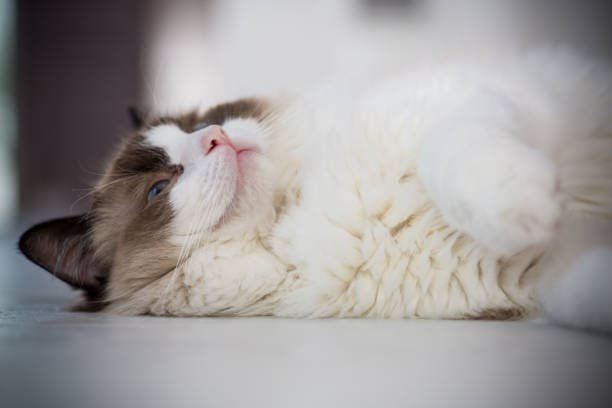
FAQs
1. What Is A Seal Bicolor Ragdoll?
A Seal Bicolor Ragdoll is a specific color variation of the Ragdoll cat breed, characterized by its distinctive coat pattern of seal-colored (dark brown) points on a lighter body with white markings.
2. How Big Do Seal Bicolor Ragdolls Typically Get?
Seal Bicolor Ragdolls are known for their large size and can grow to around 10-20 pounds when fully grown.
3. Are Seal Bicolor Ragdolls Good Pets?
Seal Bicolor Ragdolls are known to be friendly, affectionate, and gentle cats that make great companions and family pets.
4. How Should I Care For A Seal Bicolor Ragdoll’s Coat?
Caring for a Seal Bicolor Ragdoll’s coat involves regular brushing to prevent tangles and matting. A weekly grooming session with a wide-toothed comb or soft brush should suffice.
5. Are There Any Health Concerns Specific To The Breed?
While overall healthy cats, some potential health concerns for the breed include hypertrophic cardiomyopathy (a heart condition) and polycystic kidney disease. Regular vet check-ups are essential to monitor their health.

